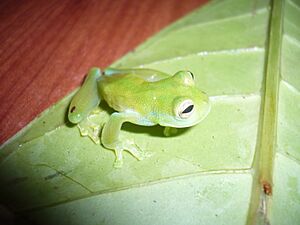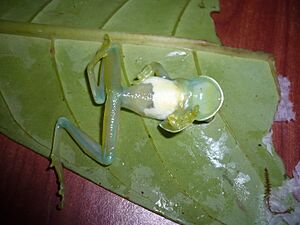Cochranella nola facts for kids
Quick facts for kids Cochranella nola |
|
|---|---|
 |
|
| Top view | |
 |
|
| Bottom view | |
| Conservation status | |
| Scientific classification |
The Cochranella nola is a special kind of frog known as a glass frog. It belongs to the family Centrolenidae. These frogs get their name because their skin on the belly is so clear you can see their insides! This frog lives only in Bolivia, in the Santa Cruz Department. It likes to live in wet mountain forests and near rivers. The name nola means "small bell" in Latin. This is because the male frog makes a high-pitched, bell-like sound when it's time to find a mate.
Contents
What Does This Frog Look Like?
The Cochranella nola is a small frog that lives in trees. Male frogs are about 21 millimeters (less than an inch) long. Females are a bit bigger, around 25 millimeters (about an inch). This frog has a short nose and small teeth. Its eyes are far apart, and its ears (called tympani) are small and hard to see.
The frog's back and sides feel a bit bumpy. Its hands and feet are smooth. It has thin legs and sticky toe pads to help it climb. There is a lot of skin between its fingers and toes, like a web. The frog's back and sides are green with tiny white spots. Its belly is white, but the back part is clear. This lets you see its yellow insides! The top of its lip is white, and its tongue is green. Its eyes have a white center with dark lines and a flat pupil. Even its bones are dark green!
Where Does This Frog Live?
Scientists first wrote about the Cochranella nola in 1996. They found it in the Santa Cruz Department in Bolivia. It lived near streams in different kinds of forests. These forests were found at heights between 500 and 1750 meters (about 1,600 to 5,700 feet) above sea level. In 2013, people found this frog in Peru for the first time. It was found in the Bahuaja-Sonene National Park in the southeast part of the country.
How Does This Frog Live?
When it's time to breed, male frogs call out near fast-moving streams. They might call from rocks in the water or from leaves a few feet above the water. Sometimes, up to six males will call together. They sit a few centimeters apart. Their calls are either single, high-pitched "pinks" that happen now and then. Or, they might make three "pinks" very quickly one after another. Female frogs lay their eggs on wet rocks.
Is This Frog Safe?
The Cochranella nola is common in the small area where it lives in Bolivia. However, it faces a threat from pollution. The streams where these frogs breed can get dirty from farm chemicals. Because of this, the International Union for Conservation of Nature has said it is "near-threatened". This means it could become endangered soon. Now that it has been found in Peru, scientists might look at its safety status again.


